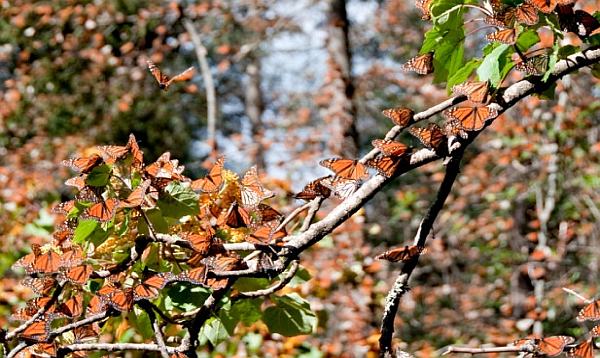Mexico City, Mexico — Mexican authorities and local residents have practically eliminated illegal logging at the Monarch Butterfly Reserve; the wintering grounds of those migrant butterflies in Michoacan, Mexico.
In his speech at the recent presentation of the "The Flight of the Monarch" documentary at Mexico City's Papalote Children’s Museum, the Federal Environmental Secretary Juan Rafael Elvira Quesada said, "we have achieved our goal of eradicating illegal logging in the core area for the Monarch, which is an important achievement that guarantees the presence of this species in Mexico."
The documentary narrates the migration route of those butterflies in Canada, the United States, and Mexico and documents the species’ natural history, ecosystem, and conservation efforts.
The secretary noted that Mexican authorities have taken very concrete measures to conserve the Monarch Butterfly Biosphere Reserve, citing efforts by federal environmental regulators to permanently and intensively inspect and monitor those wintering grounds.
The Zero Tolerance for Illegal Logging program also has been applied at the reserve with the backing of federal and state security agencies and local communities, which have formed vigilance committees.
Logging was once considered the main threat to the 193,000 acre reserve. At its peak in 2005, illegal logging in that area devastated as many as 1,140 acres annually.
According to official reports, no pine-oak forest mass has been lost at the Monarch reserve over the past two years. It is the first time that logging has not been found in detectable amounts since the mountaintop forests west of Mexico City were declared a nature reserve in 2000, according to a study of aerial photographs of mountain reserve.
The government, environmental groups, and private donors have spent millions of dollars to get residents of forest communities in the area to plant trees and start ecotourism businesses to benefit from the widespread fascination with the monarchs' yearly multi-generational migration.
 |
| According to official reports, no forest mass has been lost at the Monarch reserve over the past two years |
"This has been a successful program," said the Environmental Secretary. "We want to keep expanding it. Small-scale logging may still be going on, and that means additional efforts are needed to offer more economic alternatives to the communal farmers who live in the reserve and formerly made money from logging."
Donor groups have started nurseries in the surrounding towns to grow seedlings for reforestation efforts. These groups have simultaneously helped to build tourism facilities to give communal farmers alternative sources of income. Additionally, some local residents are paid to be part-time guards and report the presence of loggers.
The National Forestry Commission has also made nearly 6,000 conditional cash transfers to peasant communities in the area for incentives to protect forest resources.
The Mexican government now hopes to use the successful program of economic alternatives, anti-logging patrols, and payments to rural residents to solve other forestry conflicts throughout the country.
Climate Change
Climate change appears to be yet another threat affecting the forests that shelter the butterflies. Studies show that in recent years bark beetle pestilence, drought, and a parasitic plant infestation of mistletoe has caused a combined loss of almost 52 acres of pine and fir forest in the reserve.
Also heavy rain and wind storms such as those in 2010 caused forest loss due to mudslides. Government efforts to remove fallen trees from those storms have been criticized by ecologists arguing that it is better to let them lie where they fall.
Monarchs Decreasing Numbers
The numbers of butterflies spending the winter in Mexico have varied wildly in recent years. Their numbers dropped 28 percent this year, according to a report released in March, a decline some experts attribute to drought in the US and Canada where the butterflies breed and begin their long migration south.
Concern rose two years ago, when their numbers dropped by 75 percent in the wintering grounds, the lowest level since comparable record-keeping began in 1993. The numbers nearly doubled last year from that record low point.
The migration is an inherited trait; no butterfly lives to make the round-trip. The millions of orange-and-black butterflies cluster so densely on tree boughs in the reserve that researchers count them by the number of acres they cover.
Source: AP


